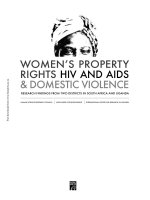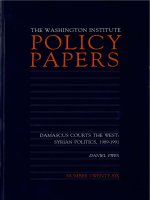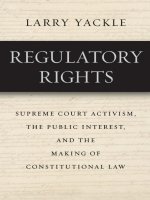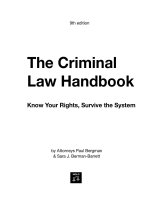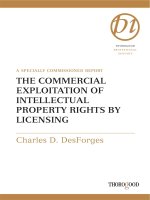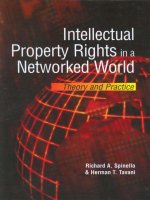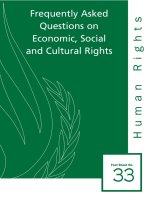WEAK COURTS, STRONG RIGHTS doc
Bạn đang xem bản rút gọn của tài liệu. Xem và tải ngay bản đầy đủ của tài liệu tại đây (785.11 KB, 289 trang )
WEAK COURTS, STRONG RIGHTS
This page intentionally left blank
WEAK COURTS, STRONG RIGHTS
JUDICIAL REVIEW AND SOCIAL WELFARE RIGHTS
IN COMPARATIVE CONSTITUTIONAL LAW
Mark Tushnet
princeton university press
princeton and oxford
Copyright © 2008 by Princeton University Press
Published by Princeton University Press, 41 William Street, Princeton, New Jersey 08540
In the United Kingdom: Princeton University Press, 3 Market Place, Woodstock, Oxfordshire
OX20 1SY
All Rights Reserved
Library of Congress Cataloging-in-Publication Data
Tushnet, Mark V., 1945–
Weak courts, strong rights : judicial review and social welfare rights in comparative
constitutional law / Mark Tushnet.
p. cm.
Includes bibliographical references and index.
ISBN-13: 978-0-691-13092-7 (hardcover : alk. paper)
1. Judicial review—United States. 2. Social rights—United States. 3. Judicial review.
4. Social rights. I. Title.
KF4575.T873 2008
347.73Ј12—dc22
2007003095
British Library Cataloging-in-Publication Data is available
This book has been composed in Goudy
Printed on acid-free paper. ϱ
press.princeton.edu
Printed in the United States of America
10987654321
TO MY COLLEAGUES
At the Georgetown University Law Center
This page intentionally left blank
Contents
Preface ix
Acknowledgments xv
Part I: Strong-Form and Weak-Form Judicial Review
Chapter 1
Why Comparative Constitutional Law? 3
Chapter 2
Alternative Forms of Judicial Review 18
Chapter 3
The Possible Instability of Weak-Form Review and Its
Implications 43
Part II: Legislative Responsibility for Enforcing the
Constitution
Chapter 4
Why and How to Evaluate Constitutional Performance 79
Chapter 5
Constitutional Decision Making Outside the Courts 111
Part III: Judicial Enforcement of Social and Economic Rights
Chapter 6
The State Action Doctrine and Social and Economic Rights 161
Chapter 7
Structures of Judicial Review, Horizontal Effect, and Social
Welfare Rights 196
Chapter 8
Enforcing Social and Economic Rights 227
Table of Cases 265
Index 269
This page intentionally left blank
Preface
This book brings together two of the important intellectual or theoretical
issues of concern to students of comparative constitutional law as it has devel-
oped in the United States over the past decade. First, what is the proper role
of courts in constitutional systems that generally comply with rule-of-law re-
quirements? Second, what substantive rights do, should, or can constitutions
guarantee? Should they protect second-generation social and economic rights
and third-generation cultural and environmental rights, and if so, how, and in
what venues? I argue that the comparative study of constitutions brings out
underappreciated connections between the answers to these two questions.
The reason is that the “new Commonwealth model” of judicial review of-
fers an important alternative to the form of judicial review familiar in the
United States.
*
In that new model, courts assess legislation against constitu-
tional norms, but do not have the final word on whether statutes comply
with those norms. In some versions the courts are directed to interpret legis-
lation to make it consistent with constitutional norms if doing so is fairly
possible according to (previously) accepted standards of statutory interpreta-
tion. In other versions the courts gain the additional power to declare
statutes inconsistent with constitutional norms, but not to enforce such judg-
ments coercively against a losing party. In still others, the courts can enforce
the judgment coercively, but the legislature may respond by reinstating the
original legislation by some means other than a cumbersome amendment
process.
I call the new model of judicial review weak-form judicial review, in con-
trast with the strong form of judicial review in the United States. Strong-form
review itself has numerous variants. At its heart is the power of courts to de-
clare statutes enacted by a nation’s highest legislature unconstitutional, and to
make that declaration practically effective by using the standard weapons at a
court’s hands—injunctions against further enforcement of the statute by exec-
utive officials, dismissals of prosecutions under the statute, awards of damages
on behalf of people injured by the statute’s operation backed up by the poten-
tial to seize the defendant’s property. (None of these weapons are powerful
enough to defeat a recalcitrant legislature and executive backed by strong
public opinion. The U.S. experience has never pushed strong-form review to
the point where its exercise has provoked a real constitutional crisis when
nonjudicial officials fight hard against a court’s orders.)
*
The terminology originated in Stephen Gardbaum, “The New Commonwealth Model of
Constitutionalism,” 49 Am. J. Comp. L. 707 (2001).
Some variants of strong-form review involve differences in the degree to
which courts defer to constitutional interpretations offered by the other
branches—interpretations sometimes described as being made by the legisla-
ture when it enacted the very legislation under constitutional challenge. An-
other variant confines strong-form review to areas directly implicating the
courts themselves. This variant, sometimes called departmentalism, allows a
court to strike down a statute unconstitutionally expanding or limiting its ju-
risdiction, the issue in the U.S. classic Marbury v. Madison (1803), or depriv-
ing plaintiffs of jury trials to which they are constitutionally entitled, and the
like. Seemingly narrower than other variants of strong-form review, depart-
mentalist review can actually be quite expansive, because any government
seeking to operate reasonably effectively is likely to call upon the courts for
assistance, at which point departmentalist strong-form review comes into
play. A statute making flag burning as a means of political protest illegal, for
example, does not in itself ask the courts to do anything, and so might seem
immune from departmentalist strong-form review. Yet, as soon as prosecutors
bring a criminal case against a flag burner, departmentalism kicks in, allowing
the courts to dismiss the case if they see the executive branch prosecutors
asking the courts’ help in enforcing what the judges find to be an unconstitu-
tional statute. Yet another variant of strong-form judicial review is judicial su-
premacy, in which the courts’ judgments of constitutionality are taken to be
conclusive on all constitutional issues that can be presented to the courts.
Every variant of strong-form judicial review raises basic questions about
democratic self-governance, because every variant allows the courts to dis-
place the present-day judgments of contemporary majorities in the service of
judgments the courts attribute to the constitution’s adopters. Of course, con-
stitutionalism is all about limiting contemporary majorities. The problem
with strong-form judicial review is that the courts’ determinations of what the
constitution means are frequently simultaneously reasonable ones and ones
with which other reasonable people could disagree. This is especially true
when the courts interpret the relatively abstract statements of principle con-
tained in bills of rights.
Take the issue of affirmative action as an example. A conscientious legisla-
ture could think about what the constitution’s ban on discrimination means
and decide that broad race-based affirmative action programs are consistent
with the nation’s commitment to equality because such programs are appro-
priate ways of rectifying the legacy of a history of racism. The courts might
conclude, in contrast, that the national commitment to equality means that
legislation can take race into account only under much more restricted cir-
cumstances, and not merely to rectify historical injustices. The conclusions
drawn by the legislature would hardly be unreasonable even if disputable. Yet,
in a system of strong-form judicial review the courts’ different conclusion, it-
self reasonable, prevails over the legislature’s. This is a substantial restriction
x • Preface
on the power of the people to govern themselves. When—as if often the
case—reasonable people can disagree about what the constitution actually
means in connection with challenges to particular statutes, the restriction
on self-government is difficult to defend simply by invoking the basic idea of
constitutionalism.
Proponents of the new model of weak-form judicial review describe it as an
attractive way to reconcile democratic self-governance with constitutional-
ism. As Jeffrey Goldsworthy puts it, the new model “offers the possibility of a
compromise that combines the best features of both the traditional models, by
conferring on courts constitutional responsibility to review the consistency of
legislation with protected rights, while preserving the authority of legislatures
to have the last word.”
†
This characteristic of weak-form judicial review is the bridge between it and
the second question I mentioned earlier, that of the propriety of incorporating
social and economic rights in constitutions. Two arguments against doing so
are widely accepted: courts, it is said, lack the capacity to give appropriate con-
tent to general social welfare rights in the context of particular controversies,
and, it is said as well, judicial enforcement of social welfare rights is particularly
intrusive on legislative—and therefore democratic—choice because enforcing
social and economic rights typically has substantially larger implications for a
government’s budgets than enforcing first-generation rights does. The creation
of weak-form review undermines these arguments by providing an institutional
mechanism for the provisional identification and enforcement of social and
economic rights. Weak-form systems allow legislatures to respond to judicial
decisions by saying that the courts misspecified the content of constitutional
social or economic rights, or insisted on excessively expensive modes of realiz-
ing such rights.
I begin in chapter 1 by arguing for the value of comparative constitutional
study, not to determine the proper interpretation of specific constitutional pro-
visions but rather to assist thinking about issues of domestic constitutional law.
This methodological point pervades the book. Chapters 2 and 3 then intro-
duce and examine in some detail the different forms of judicial review, with
particular attention to the less familiar weak forms. Chapter 3 draws on the
experience in weak-form systems over the past few decades to ask whether
weak-form systems are stable, in the sense that they remain weak-form and do
not have a tendency to become strong-form systems—and, if they are not sta-
ble in that sense, how such a transformation might be explained and perhaps
justified.
Part 2 turns to a question implicit in the argument that, in Goldworthy’s
terms, weak-form systems are attractive in part because they preserve legisla-
tive authority: weak-form systems assume that legislatures given responsibility
Preface • xi
†
Jeffrey Goldsworthy, “Homogenizing Constitutions,” 23 Ox. J. Leg. Stud. 484, 484 (2003).
for participating in the development of constitutional meaning, in dialogue
with the courts, will do so reasonably well. Many people, including many of
this book’s readers, will be skeptical about the claim that legislatures, staffed
by politicians interested more in reelection than in advancing the constitu-
tion’s commitments, will actually do a decent job of it. After identifying the
precise questions we ought to ask about legislative performance and indicat-
ing some difficulties in investigating actual legislative performance, chapter 4
develops criteria for evaluating the quality of legislative performance in the
constitutional arena. These criteria are complex and, perhaps surprisingly,
much more generous to legislatures than one might have thought beforehand.
Chapter 5 provides some case studies in actual legislative performance, with
those criteria in mind. The case studies also bring out some aspects of consti-
tutional design in both strong-form and weak-form systems that affect legisla-
tive performance.
Part 3 then takes up social and economic rights themselves, connecting the
institution of weak-form judicial review to those rights. It addresses two argu-
ments prominent in skeptical discussions of judicial enforcement of social and
economic rights, particularly in connection with the U.S. Constitution. The
first is that doing so is novel, that the U.S. Constitution is a constitution of
negative rights, in contrast to the positive social and economic rights con-
tained in more recently adopted constitutions. The second is that doing so is
beyond judicial capacity, especially because coercive judicial enforcement of
social and economic rights interferes with legislative prerogatives more sub-
stantially than judicial enforcement of classical liberal rights. Part 3 argues
that each of these arguments is mistaken. Chapter 6 looks at the so-called
state action doctrine in U.S. constitutional law and the related doctrines of
horizontal effect in other constitutional systems and demonstrates that, under
the guise of enforcing that doctrine (or of considering whether to give consti-
tutional provisions horizontal effect), constitutional courts already enforce
such rights, thereby weakening the “novelty” objection. Drawing on experi-
ence in the United States and Canada, I show that liberal constitutions
cannot avoid the question of social welfare rights because they must do some-
thing about the constitutional implications of what I call the background
rights of property, contract, and tort law. I then argue that substantive consti-
tutional law is entirely adequate to deal with whatever troubling implications
the constitutionalization of social welfare rights is something thought to have.
Chapters 7 and 8, drawing on South Africa’s developing jurisprudence of
social welfare rights, show that the “capacity” objection to judicial enforce-
ment of social and economic rights rests on the assumption that such enforce-
ment must take a strong form, and argues that this assumption is weakened by
the creation of weak-form judicial review, which might be an attractive
method for enforcing social and economic rights. Weak-form judicial review
can recognize social welfare rights in a way that has no larger implications for
xii • Preface
government budgets than do judicial decisions enforcing such first-generation
rights as the right to free speech.
The argument in part 3 does not establish that enforcing social and eco-
nomic rights is necessarily a good thing; it simply attempts to clear away some
rather thick underbrush that has developed around the issue so that other ar-
guments about enforcing those rights—for example, that doing so will have
good or bad effects on a nation’s economy—can take their proper, prominent
place in our consideration of the question. Nor, of course, does the argument
attempt to explain why the United States has a strong-form system of judicial
review or to examine the political reasons (as distinct from the institutional
reasons associated specifically with judicial review) that might explain why
substantive arguments for social and economic rights have so little purchase
in U.S. political discourse.
w
One point of terminology (or typography): Throughout this book, I use
phrases like the constitution with a small c when I am referring to the constitu-
tion of a generic democratic nation. I capitalize Constitution when I am refer-
ring to a specific constitution, which I identify either immediately (as in “U.S.
Constitution”) or in the sentences preceding the reference.
Preface • xiii
This page intentionally left blank
Acknowledgments
Material in the book previously appeared, in a different form, in the follow-
ing publications and is reprinted with permission of the publishers:
“Alternative Forms of Judicial Review,” Reprinted from the Michigan Law
Review, August 2003, vol. 101, No. 8. Copyright 2003 by The Michigan
Law Review Association.
“Book Review,” 2 International Journal of Constitutional Law 734 (2004).
“Evaluating Congressional Constitutional Interpretation: Some Criteria
and Two Informal Case Studies,” 50 Duke Law Journal 1395 (2001).
“Forms of Judicial Review as Expressions of Constitutional Patriotism,” 22
Law and Philosophy 353 (2003). Copyright © 2003 Kluwer Academic
Publishers. No part of the material protected by this copyright notice may
be reproduced or utilized in any form or by any means, electronic or me-
chanical, including photocopying, recording or by any information storage
and retrieval system, without written permission from the copyright
owner. Reprinted with kind permission of Springer Science and Business
Media.
“Institutions for Implementing Constitutional Law,” originally published
in Rethinking Political Institutions: The Art of the State (Ian Shapiro,
Stephen Skowronek, and Daniel Galvin, eds., New York University Press,
2006).
“Interpretation in Legislatures and Courts: Incentives and Institutional
Design,” in The Least Examined Branch: The Role of Legislatures in the
Constitutional State (Richard W. Bauman and Tsvi Kahana eds. 2006).
Reprinted with permission of the publisher, Cambridge University Press
© 2006.
“Interpreting Constitutions Comparatively: Some Cautionary Notes, with
Reference to Affirmative Action,” 36 Connecticut Law Review 649
(2004).
“Judicial Activism or Restraint in a Section 33 World,” 52 University of
Toronto Law Journal 89 (2002). © University of Toronto Press Incorpo-
rated 2003. All rights reserved.
“New Forms of Judicial Review and the Persistence of Rights- and
Democracy-Based Worries,” 38 Wake Forest Law Review 813 (2003).
“Social Welfare Rights and the Forms of Judicial Review,” 82 Texas Law
Review 1895 (2004). Reprinted with permission of the publisher, Texas
Law Review © 2004.
“State Action and a New Birth of Freedom,” 92 Georgetown Law Journal
779 (2004) (with Gary Peller). Reprinted with permission of the pub-
lisher, Georgetown Law Journal © 2004.
“State Action, Social Welfare Rights, and the Judicial Role: Some Com-
parative Observations,” 3 University of Chicago Journal of International
Law 435 (2002). Reprinted with permission of the publisher, Chicago
Journal of International Law © 2002.
“The Issue of State Action/Horizontal Effect in Comparative Constitu-
tional Law,” 1 International Journal of Constitutional Law 79 (2003).
“Weak-Form Judicial Review: Its Implications for Legislatures,” (2004)
S.C.L.R. (2d) 213, and in Constitutionalism in the Charter Era (Grant
Huscroft and Ian Brodie eds., 2005).
xvi • Acknowledgments
PART I
Strong-Form and Weak-Form Judicial Review
This page intentionally left blank
CHAPTER 1
Why Comparative Constitutional Law?
Recent Supreme Court opinions mentioning constitutional decisions by
courts outside the United States have generated a strong—and grossly
overstated—critique by conservative commentators.
1
The thrust of the
critique is that these opinions portend inroads on the sovereign ability of
the American people to govern ourselves, and the embedding in the U.S.
Constitution—through judicial interpretation—of the values of a cosmo-
politan elite that could not persuade the American people to adopt those
values through purely domestic legal processes.
Only a brief comment on these “arguments” is appropriate here.
2
First,
Supreme Court mention of decisions by courts outside the United States is no
recent development, but at most a revival of an earlier tradition that had been
submerged for perhaps a decade or two.
3
Second, mention is the right word.
Only one recent opinion relies on the substance of a decision by a non-U.S.
court to support a proposition that played some role in the Court’s reasoning.
4
Other references to such decisions have been in the form of factual observa-
tions about what other courts have done. Third, the idea that references to
non-U.S. decisions might somehow produce decisions that would not be
reached by using other materials for interpreting the Constitution is quite im-
plausible. It seems to require that some justice who would not otherwise be
1
The most prominent are Robert Bork and Richard Posner. See Robert H. Bork, Coercing
Virtue: The Worldwide Rule of Judges (2003); Richard A. Posner, “Foreword: A Political Court,”
119 Harv. L. Rev. 31, 85–88 (2005). Probably the most extended analysis is Roger P. Alford, “In
Search of a Theory for Constitutional Comparativism,” 52 UCLA L. Rev. 639 (2005).
2
For my more extended observations, see Mark Tushnet, “Transnational/ Domestic Constitu-
tional Law,” 37 Loyola L.A. L. Rev. 239 (2003); Mark Tushnet, “When Is Knowing Less Better
than Knowing More? Unpacking the Controversy Over Supreme Court Reference to Non-U.S.
Law,” 90 Minn. L. Rev. 1275 (2006); Mark Tushnet, “Referring to Foreign Law in Constitutional
Interpretation: An Episode in the Culture Wars,” 35 Balt. L. Rev. 299 (2006).
3
For a compilation of materials showing how long the tradition is (with some effort to massage
the characterization of the tradition to establish the novelty of recent references to non-U.S.
law), see Steven G. Calabresi & Stephanie Dotson Zimdahl, “The Supreme Court and Foreign
Sources of Law: Two Hundred Years of Practice and the Juvenile Death Penalty Decision,” 47
Wm. & Mary L. Rev. 743 (2005).
4
Lawrence v. Texas, 539 U.S. 558 (2003), referred to a 1981 decision by the European Court
of Human Rights to show the inaccuracy of an assertion made in 1985 by then chief justice
Warren Burger that “condemnation of [homosexual] practices is firmly rooted in Judeo-Christian
moral and ethical standards.” Bowers v. Hardwick, 478 U.S. 186, 196 (Burger, C. J., concurring).
persuaded by those other materials would nonetheless change his or her mind
when confronted with the non-U.S. materials. That might happen, someday,
for one justice perhaps, but surely not on a large enough scale for anyone to
care about. Fourth, the concern about sovereignty seems equally misplaced.
The U.S. Supreme Court is, after all, a domestic lawmaker no less than is, for
example, the U.S. Senate, which ratifies treaties limiting what the U.S. gov-
ernment as a whole can do. That is, a domestic institution would impose any
restrictions on U.S. lawmaking by references to non-U.S. court decisions.
There is no impairment of sovereignty in that. And, finally, the concerns
about self-government expressed by critics of these Supreme Court decisions
are valid ones—when made about judicial review itself. There is nothing,
though, that distinguishes non-U.S. decisions from anything else the Court
might rely on to limit self-government through judicial review.
This recent tempest in a teapot has placed the question of the value of com-
parative constitutional study on the table. Why study comparative constitu-
tional law? For a scholar, of course, the value seems obvious: more knowledge
is generally better than less. Others have a more instrumental interest. They
might want to know whether studying comparative constitutional law might
improve our ability to make domestic constitutional law. Responding to that
inquiry requires some examination of how we can actually do comparative
constitutional law.
5
I confine my attention to questions implicated in doing comparative con-
stitutional law as law. There is, of course, a large field of comparative studies
of governmental organization, conducted by political scientists as well as
lawyers, and some of that field overlaps with the field of comparative constitu-
tional law. There is, though, one large difference between the fields. Compar-
ative constitutional law involves doing law. And, as I have learned, it is quite
difficult to be comfortable in doing law in more than one legal system. Even
when language barriers do not intervene, legal cultures do. For example,
I have been persuaded—despite my initial skepticism—that Australian con-
stitutional culture is far more formalist than U.S. constitutional culture. It is
less open to what seem to me the inevitable intellectual challenges from those
influenced by American legal realism and its legacy. As a result, constitutional
doctrines in Australia, such as those dealing with the allocation of authority
between the national and the state governments, are more stable than similar
doctrines in the United States, even doctrines framed in language that seems
4 • Chapter 1
5
There is a large literature on the methods of comparative law generally. The more general
field, though, has included discussions of matters that I personally find not terribly interesting,
such as the classification of legal systems into families and the phenomenon of borrowing by one
legal system or tradition from another. For examples of writing in comparative constitutional law
on the latter topic, see Constitutionalism and Rights: The Influence of the United States Consti-
tution Abroad (Louis Henkin & Albert Rosenthal eds., 1990); Symposium on Constitutional
Borrowing, 1 Int’l J. Con. L. 181–324 (2003).
Why Comparative Constitutional Law? • 5
parallel to that used in the Australian cases. These and other differences in
constitutional cultures complicate the task of doing comparative constitu-
tional law, perhaps to the point where the payoff in any terms other than the
increase of knowledge is small.
An Overview of Methods in Comparative Constitutional Law
I think it useful to identify two ways of doing comparative constitutional law,
as a preliminary to criticizing and deepening them to suggest a third method.
Without insisting that they are sharply different, I call the first two methods
normative universalism and functionalism.
6
These two methods involve efforts
to see how constitutional ideas developed in one system might be related to
those in another, either because the ideas attempt to capture the same norma-
tive value or because they attempt to organize a government to carry out the
same tasks. I call the third method contextualism. This method comes in
two variants, which I call simple contextualism and expressivism. Simple con-
textualism insists that constitutional ideas can be understood only in the full
institutional and doctrinal context within which they are placed. Expres-
sivism takes constitutional ideas to be expressions of a particular nation’s self-
understanding. Both methods raise questions about the coherence of the idea
that constitutional ideas can migrate (without substantial modification) from
one system to another.
7
Universalism and Functionalism
Normative universalism emerges primarily from the dialogue between those
who study comparative constitutional law and those who study internat-
ional human rights. The idea is simple: constitutionalism itself entails—
everywhere—some fundamental principles. Some of those principles involve
human rights: the protection of some universal human rights, such as rights
to political participation, to equal treatment under the law, to freedom of
6
There is a sense in which normative universalism and functionalism are variants of a more
general universalism, as will become clear later. I have been unable to devise labels that preserve
a parallelism in formulations, though.
7
It may be worth noting that legal scholars attracted to normative universalism are likely to be
influenced by normative jurisprudence and political theory, that those attracted to functionalism
are likely to be influenced by political scientists, and that those attracted to contextualism are
likely to be influenced by anthropologists. And here yet another complexity intrudes. Not only
will the scholar of comparative constitutional law have to be comfortable in more than one con-
stitutional system, but he or she may think it helpful to be comfortable with the discipline other
than law that seems likely to illuminate comparative constitutional questions in the way the legal
scholar finds useful.
conscience and expression, and, for many human rights advocates, much
more. Others involve structures of government. Here the list is typically
shorter: independent courts for sure, perhaps some version of the separation
between law enactment and law execution (another aspect of the separation
of powers), and probably little more.
Universalists study comparative constitutional law to identify how particu-
lar constitutions instantiate those universal principles. By comparing different
versions, we can better understand the principles themselves. Then we might
be able to improve a domestic system’s version of one or another principle by
using that enhanced understanding to modify it.
Three examples from free speech law, two controversial, the other not,
illustrate the universalist method in comparative constitutional law. The un-
controversial one is the law of sedition, a criminal offense consisting of criti-
cism of existing government policies. Over the past century, the United States
Supreme Court has grappled with the problem of reconciling the law of sedi-
tion with the First Amendment’s protection of free expression. Its sustained
attention to the problem has yielded two conclusions. The first is widely ac-
cepted. Government efforts to suppress speech critical of its policies must be
treated with extreme skepticism, captured variously in formulations like “clear
and present danger” or “intended to and likely to cause imminent lawless con-
duct.”
8
The latter formulation indicates the second conclusion we can draw
from the U.S. sedition cases. The problem of seditious speech, analysis has
shown, is only one aspect of a broader problem—how can governments regu-
late speech that, they fear, will cause people to break the law?
Governments around the world have confronted the problem of seditious
speech, and all governments must deal with the problem of speech that in-
creases the risk that laws will be broken. Comparative constitutional study
allows us to examine the different ways in which they deal with the prob-
lem. And, most scholars and many constitutional courts believe, something
like the U.S. approach is the best one available.
9
The European Court of
Human Rights, for example, has dealt with cases arising out of Turkey’s
often violent confrontation with the Kurdish separatist movement there.
One, decided in 2000, involved a newspaper article by the president of a
major labor union, in which the author said that “not only the Kurdish peo-
ple but the whole of our proletariat must stand up against” the nation’s anti-
Kurdish laws and policies.
10
The Court wrote that “there is little scope [in
the applicable international human rights law] for restrictions on political
speech,” but that governments could limit free expression when a speech
6 • Chapter 1
8
Dennis v. United States, 341 U.S. 494 (1951) (the most recent version of the “clear and
present danger” test in the United States); Brandenburg v. Ohio, 395 U.S. 444 (1968) (the “im-
minent lawless conduct” test).
9
I return to the problem of sedition law in chapter 3.
10
Ceylan v. Turkey, 30 EHRR 73 (2000), ¶ 8.
“incites to violence against an individual, a public official or a sector of the
population.”
11
The law of personal libel provides a second example. Here the United
States has adopted a notably stringent rule restricting the circumstances
under which a person the Supreme Court calls a public figure can recover
damages for the publication of a false statement that injures his or her reputa-
tion. The category of public figures is a large one in the United States, includ-
ing leaders of large private corporations and prominent football coaches and
celebrities as well as politicians.
12
Public figures can win only actual damages,
which are usually relatively small, and even then only if they show that the
false statements were made by someone who knew they were false or at least
made a conscious decision to forgo any effort to find out whether they were
true or false.
13
Not surprisingly, other constitutional courts regularly confront libel cases
brought by public figures. They have reached a range of conclusions, but none
is nearly as restrictive of recovery as is the United States. For example,
Australia uses a test of reasonableness. One major formulation was offered in
a case brought there by a member of New Zealand’s parliament who had been
that nation’s prime minister:
[A] defendant’s conduct . . . will not be reasonable unless the defendant had reason-
able grounds for believing that the imputation [of something that damages reputa-
tion] was true, took proper steps, so far as they were reasonably open, to verify the
accuracy of the material and did not believe the imputation to be untrue. Further-
more, the defendant’s conduct will not be reasonable unless the defendant has
sought a response from the person defamed and published the response (if any) made
except in cases where the seeking or publication of a response was not practicable.
14
Many in the United States find our domestic law of libel unsatisfactory.
15
Universalist scholars of comparative constitutional law suggest that looking at
the solutions that other constitutional democracies have come up with would
help us develop a better law of libel.
Why Comparative Constitutional Law? • 7
11
Id., ¶ 34.
12
See Barbara Singer, “The Right of Publicity: Star Vehicle or Shooting Star?” 10 Cardozo
Arts & Ent. L. J. 1, n. 1 (1991).
13
The term the Supreme Court uses is that the false statements must be made with malice, but
the decisions make it clear that the term refers not to some mental state like having it in for the
public figure, but rather to knowledge of the statement’s falsity or willful disregard of its truth or
falsity.
14
Lange v. Australian Broadcasting Corp., (1997) 189 CLR 520 (Aust. High Ct.) (opinion of
Brennan, C. J.).
15
See David A. Anderson, “Is Libel Law Worth Saving?” 140 U. Pa. L. Rev. 497 (1991); see
also James Penzi, “Libel Actions in England, a Game of Truth or Dare? Considering the Recent
Upjohn Cases and the Consequences of ‘Speaking Out,’ ” 10 Temp. Imt’l & Comp. L. J. 211
(1996) (comparing English and U.S. libel laws).
The most controversial example involves the regulation of hate speech.
Proponents of more extensive regulation of hate speech in the United States
often refer to transnational constitutional norms—the existence of hate
speech regulation in Canada,
16
the existence in some international human
rights treaties of a duty to regulate hate speech
17
—in defending the proposi-
tion that hate speech regulation should not be treated as unconstitutional
under the First Amendment to the U.S. Constitution.
18
They argue, quite
rightly, that the fact that modern liberal democracies do in fact regulate hate
speech without descending into totalitarian tyrannies where the government
engages in extensive thought control shows that hate speech regulation in it-
self is compatible with a system that respects general norms of free expression.
They conclude that hate speech regulation in the United States could be
adopted without risking anything other than making the United States more
like Canada—not, in their view, an obviously bad thing.
Again, this exemplifies the universalist use of comparative constitutional
law. According to universalists, general principles of free expression and
human dignity come into play when someone makes a speech castigating a
racial, religious, or national group. Examining how a number of nations have
worked out accommodations between those principles might be useful in de-
veloping the contours of any nation’s domestic law dealing with hate speech.
The functionalist approach to comparative constitutional law is similar to
the universalist one to the extent that it tries to identify things that happen
in every constitutional system that is the object of study. So, for example,
every democratic nation has to have a mechanism in place for going to war
or for dealing with domestic emergencies that threaten the nation’s continu-
ing existence. But, the functionalist analysis goes, democratic nations should
be careful about going to war, and about determining that a truly grave emer-
gency exists. Functionalists believe that examining the different ways in
which democratic nations organize the processes of going to war and declar-
ing emergencies can help us determine which are better and which are worse
processes.
As the example of war-making and emergencies suggests, functionalists
tend to focus on issues of government structure. With respect to federalism,
8 • Chapter 1
16
See, e.g., Regina v. Keegstra, [1990] S.C.R. 697.
17
International Covenant on Civil and Political Rights, art. 20(2) (“Any advocacy of na-
tional, racial or religious hatred that constitutes incitement to discrimination, hostility or vio-
lence shall be prohibited by law.”); International Convention on the Elimination of All Forms of
Racial Discrimination, art. 4(a) (States Parties “[s]hall declare as an offence punishable by law all
dissemination of ideas based on racial superiority or hatred, incitement to racial discrimination”).
18
See, e.g., Mari Matsuda, “Public Response to Racist Speech: Considering the Victim’s
Story,” 87 Mich. L. Rev. 2320, 2341–48 (1989) (describing the development of international
human rights law in connection with hate speech); john r. powell, “As Justice Requires/Permits:
The Delimitation of Harmful Speech in a Democratic Society,” 16 Law & Inequality 97, 147–50
(1998) (discussing Keegstra).
